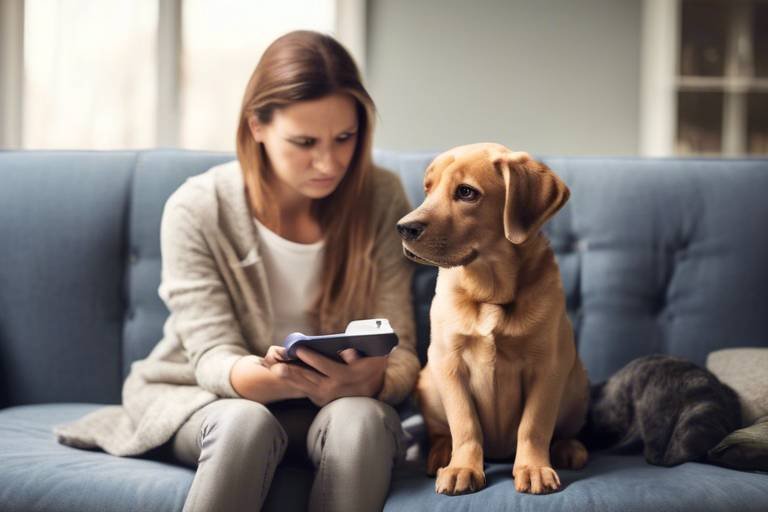Understanding Separation Anxiety in Pets
Separation anxiety in pets is a common issue that many pet owners face, and understanding it is the first step towards finding effective solutions. Just like humans, our furry companions can experience emotional distress when left alone. Imagine being in a crowded room and suddenly being left by your friends; the feeling of isolation can be overwhelming. Pets, especially dogs and cats, can feel similarly when their beloved humans leave them, leading to a range of behavioral and physical symptoms. In this article, we will explore the causes, signs, and effective solutions to help our pets cope better when we are not around.
So, what exactly causes separation anxiety in our pets? The root causes can vary widely. Some pets may have experienced traumatic events, such as being abandoned or losing a previous owner. Others might develop anxiety due to changes in their routine, such as moving to a new home or the arrival of a new family member. Understanding these triggers is crucial for pet owners, as it allows them to address the underlying issues and create a more secure environment for their furry friends.
Recognizing the signs of separation anxiety is also essential. Pets may exhibit various behavioral indicators, such as excessive barking, destructive chewing, or inappropriate elimination. For example, if your dog starts chewing on furniture or scratching at doors when you leave, it could be a cry for help. Additionally, vocalization is a common way pets express their anxiety. If your dog is barking or whining excessively when you leave, it’s important to take notice and respond appropriately. These behaviors are not just annoying; they are signals that your pet is struggling emotionally.
Physical symptoms of separation anxiety can also manifest in our pets. You might notice excessive drooling, pacing back and forth, or even gastrointestinal issues like diarrhea. These signs indicate that your pet is under significant stress, and recognizing them is key to providing comprehensive care. By paying attention to both behavioral and physical symptoms, pet owners can better understand their pets' emotional states and take appropriate action.
In conclusion, understanding separation anxiety in pets is vital for their well-being. By recognizing the causes and symptoms, pet owners can create a supportive environment that helps their furry friends feel more secure when left alone. In the following sections, we will delve deeper into effective solutions, including training techniques and environmental adjustments, to help alleviate this distressing condition.
- What are the main causes of separation anxiety in pets? Separation anxiety can be caused by previous trauma, changes in routine, or lack of socialization.
- How can I tell if my pet has separation anxiety? Look for signs such as excessive barking, destructive behavior, or physical symptoms like drooling.
- What are some effective training techniques to help my pet? Positive reinforcement training can help pets associate being alone with positive experiences.
- Can environmental adjustments help with separation anxiety? Yes, creating a safe space and using calming aids can significantly reduce anxiety levels in pets.

Causes of Separation Anxiety
Understanding the root causes of separation anxiety in pets can help owners recognize triggers and address them effectively, ensuring a happier and healthier emotional state for their companions. Just like humans, pets can experience anxiety when they feel insecure or fearful, especially when left alone. One of the most common causes is a lack of early socialization. Puppies that haven't been exposed to various environments, people, and other animals during their critical development stages may struggle with being alone later in life.
Another significant factor is previous traumatic experiences. Pets that have been abandoned, rehomed, or subjected to harsh treatment may develop anxiety when they sense that their owner is about to leave. This fear of abandonment can manifest in various ways, making it essential for owners to understand their pet's history. Additionally, changes in routine, such as a new job or a family member moving in or out, can disrupt a pet's sense of security, leading to anxiety. Just think of it as a pet's version of a rollercoaster ride—exciting at first, but potentially overwhelming if the ride is too intense!
Moreover, certain breeds are predisposed to separation anxiety. For example, herding breeds like Border Collies and Australian Shepherds often form strong attachments to their owners and can struggle when left alone. It's crucial for owners of these breeds to be aware of their pet's inherent tendencies and plan accordingly. In some instances, a pet's anxiety may also stem from medical issues, such as hormonal imbalances or neurological disorders, which can exacerbate their stress levels. Therefore, if a pet's behavior changes suddenly, a visit to the vet is always a wise decision.
In summary, the causes of separation anxiety in pets can be multifaceted, involving a mix of environmental factors, genetics, and past experiences. By understanding these underlying issues, pet owners can better equip themselves to provide the necessary support and interventions to help their furry friends feel more secure and comfortable when left alone.

Signs and Symptoms
Identifying the signs and symptoms of separation anxiety in pets is crucial for pet owners. Just like us, our furry friends can experience stress and anxiety when left alone, and it’s important to recognize these emotional cues early on. The behaviors exhibited by anxious pets can range from subtle to overt, and understanding these signs can help you intervene before the situation escalates. So, what should you be on the lookout for? Let’s dive into some common indicators that your pet may be struggling with separation anxiety.
One of the first things you might notice is a change in your pet's behavior. Excessive barking, for instance, can become a frequent issue. This vocalization is not just a call for attention; it’s often a cry of distress. If your dog is barking incessantly when you leave, it’s a strong indicator that they are feeling anxious. Similarly, destructive chewing can signal that your pet is trying to cope with their anxiety. Chewing furniture, shoes, or even their own paws can be a form of self-soothing, albeit a damaging one. Lastly, inappropriate elimination—like urinating or defecating inside the house—can also indicate that your pet is experiencing high levels of anxiety when left alone.
Vocalization is a primary way many pets express their anxiety. Dogs may bark, whine, or howl, while cats might meow excessively or even yowl. This behavior is not just annoying; it’s a signal that your pet is feeling distressed. If you notice your pet becoming increasingly vocal as you prepare to leave, it’s time to assess their emotional state. Understanding this behavior helps owners respond appropriately to their pet’s emotional needs. Instead of getting frustrated, consider it a call for help from your furry companion.
Destructive behaviors can manifest in various ways, such as chewing on furniture or scratching at doors. This behavior often stems from anxiety and frustration. Pets may feel trapped in their environment and resort to these actions as a way to relieve their stress. To mitigate damage and improve your pet's emotional well-being, it’s essential to address these behaviors early on. Providing appropriate chew toys or engaging in more interactive playtime can help redirect their energy and reduce anxiety.
Separation anxiety doesn’t just affect behavior; it can also manifest physically. For instance, you may notice your pet experiencing excessive drooling or pacing around the house. These physical symptoms can be alarming and indicate that your pet is in distress. Additionally, gastrointestinal issues, such as diarrhea or vomiting, can also be linked to anxiety. It's important to monitor these signs closely, as they can lead to more serious health concerns if left unaddressed. If you observe any of these physical symptoms, it may be time to consult your veterinarian for further advice and support.
In summary, being vigilant about your pet's signs and symptoms of separation anxiety is vital. By recognizing behavioral and physical indicators, you can take proactive steps to help your furry friend feel more secure and comfortable when left alone. Remember, your pet relies on you to understand their needs and provide the support they require.
- What should I do if my pet shows signs of separation anxiety? - Start by consulting with a veterinarian or a professional trainer who specializes in behavioral issues.
- Can separation anxiety be cured? - While it may not be completely "cured," it can be managed effectively with the right strategies and support.
- Are certain breeds more prone to separation anxiety? - Yes, some breeds, particularly those that are highly social or have strong attachments to their owners, may be more susceptible.
Behavioral Indicators
When it comes to understanding separation anxiety in pets, are often the first signs that something is amiss. Just like humans, our furry friends have their own unique ways of expressing distress. If you notice your pet acting out in unusual ways when you prepare to leave, it’s essential to pay attention. The sooner you recognize these signs, the quicker you can take action to help your companion feel more secure.
One of the most common behavioral indicators of separation anxiety is excessive barking. This vocalization can range from a few whines to a full-blown symphony of howls and barks that might even make your neighbors raise an eyebrow. Think of it as your pet's way of saying, "Hey! Where are you going? Don't leave me!" It's not just noise; it's a cry for help. Addressing this behavior early can prevent it from becoming a habit.
Another significant sign is destructive behavior. If you come home to find your favorite pair of shoes chewed up or the couch cushions scattered across the living room, your pet might be expressing their anxiety through destruction. This behavior isn’t just about being naughty; it’s a physical manifestation of their distress. They might be trying to cope with the overwhelming feeling of being alone, and chewing or scratching can be a way to release that pent-up energy. If you see this happening, it’s crucial to intervene and redirect their energy in a more positive way.
In addition to barking and destruction, you might notice your pet engaging in inappropriate elimination. This means they might urinate or defecate in the house, even if they are usually well-trained. This behavior can be particularly distressing, not just for the pet but also for the owner. It's essential to understand that this is not a sign of defiance but rather a symptom of their anxiety. They may feel so stressed that they lose control of their bodily functions. Addressing this issue with patience and understanding is key.
When observing your pet, also consider their overall demeanor. Are they pacing back and forth, unable to settle down? This restlessness can indicate that they are feeling anxious and unsure. It’s like when you’re waiting for an important call and can’t sit still; your pet is experiencing that same level of anxiety. Recognizing these signs can help you create a more comforting environment for your pet.
In conclusion, understanding these behavioral indicators is crucial in identifying separation anxiety in pets. By being observant and proactive, you can help your furry friend navigate their feelings and build a more secure emotional state. Remember, your pet relies on you to interpret their needs and provide the comfort they crave.
- What is separation anxiety in pets?
Separation anxiety is a condition where pets experience extreme distress when left alone. This can manifest in various behaviors, including excessive barking, destruction of property, and inappropriate elimination.
- How can I tell if my pet has separation anxiety?
Look for signs such as excessive vocalization, destructive behavior, restlessness, and inappropriate elimination. If your pet exhibits these behaviors specifically when you leave, it may indicate separation anxiety.
- What can I do to help my pet with separation anxiety?
Training techniques, environmental adjustments, and providing comfort items can help. Consider creating a safe space for your pet and using positive reinforcement to associate your departures with positive experiences.
Vocalization
When it comes to understanding our furry friends, vocalization is one of the most telling signs of their emotional state. Just like humans express their feelings through words and sounds, pets communicate their anxiety through various forms of vocalization, including barking, whining, and howling. Imagine being left alone in a crowded room and feeling utterly isolated; that’s how pets might feel when they are separated from their owners. Their vocal expressions are a cry for help, a way to signal that they are not okay.
For many pet owners, the sound of their dog barking or their cat meowing can be both concerning and frustrating. However, it’s essential to understand that these vocalizations are not just annoying noises; they are an integral part of your pet’s emotional language. When a pet vocalizes excessively, it often indicates a high level of distress. This behavior can manifest in different ways, such as:
- Barking: Dogs may bark continuously when they feel anxious, especially if they hear noises from outside or sense their owner's departure.
- Whining: This high-pitched sound is often a plea for attention or reassurance, signaling that your pet is feeling uneasy.
- Howling: Some dogs howl when they are lonely, mimicking their ancestors who used howling as a means of communication.
It’s crucial for pet owners to pay attention to these vocalizations, as they can provide valuable insights into their pet’s mental health. Ignoring these signs can lead to further anxiety and behavioral issues. For instance, if a dog is barking excessively, it may not just be a nuisance; it could indicate that the dog is suffering from separation anxiety, which needs to be addressed promptly.
So, what can you do if your pet is vocalizing excessively? First, it’s important to identify the triggers. Is your pet vocalizing only when you leave the house, or does it happen at other times too? Keeping a journal of your pet’s behavior can help you pinpoint specific patterns. Once you have identified the triggers, you can work on strategies to reduce their anxiety. For instance, providing your pet with interactive toys or engaging them in play before you leave can help distract them and reduce vocalization.
In conclusion, vocalization is a significant indicator of separation anxiety in pets. By understanding the reasons behind these sounds, pet owners can take proactive steps to ensure their furry companions feel secure and loved, even when they are alone. Remember, your pet’s voice is their way of communicating with you, so listen closely!
- What should I do if my pet is barking excessively when I leave? Consider training techniques that promote positive reinforcement and gradually acclimate your pet to being alone.
- Are there specific breeds more prone to separation anxiety? Yes, certain breeds, like Labrador Retrievers and German Shepherds, may be more susceptible due to their strong attachment to their owners.
- Can medication help with my pet’s anxiety? In some cases, veterinarians may prescribe medication to help manage severe anxiety, but it should be accompanied by behavioral training.
Destructive Behavior
Destructive behavior in pets, particularly when it stems from separation anxiety, can be both alarming and frustrating for pet owners. Imagine coming home after a long day to find your beloved furry friend has turned your favorite couch into a chew toy or has left a trail of shredded shoes in their wake. This behavior is not just a nuisance; it’s a clear indication that your pet is struggling emotionally. When pets experience anxiety from being left alone, they may resort to destructive actions as a way to cope with their feelings of distress.
Understanding why your pet engages in such behavior is crucial. Often, pets feel a sense of abandonment when their owners leave, leading to panic and an overwhelming need to escape their perceived confinement. This can manifest in various ways, including:
- Chewing: Pets may chew on furniture, shoes, or other household items as a way to relieve their anxiety.
- Scratching: Dogs and cats alike may scratch at doors or windows, desperately trying to get to their owners.
- Digging: Some pets may dig at carpets or floors, which can lead to significant damage.
These behaviors are not merely acts of defiance or mischief; they are cries for help. When a pet feels overwhelmed, their instinct might be to engage in destructive behavior as a form of self-soothing. This can lead to a vicious cycle where the pet’s anxiety increases, leading to more destruction, which in turn causes the owner to react negatively, further exacerbating the pet's fear.
To address destructive behavior effectively, it’s essential to implement a combination of training and environmental adjustments. For instance, providing your pet with appropriate chew toys can redirect their energy away from your furniture. Additionally, creating a safe and comfortable space for your pet to relax can significantly reduce their anxiety levels. This space should be equipped with their favorite toys, a cozy bed, and perhaps some calming music or pheromone diffusers to create a soothing atmosphere.
Ultimately, patience and understanding are key. Just as humans need time to adjust to new situations, so do our pets. By recognizing the underlying causes of their destructive behavior and responding with compassion and appropriate interventions, pet owners can help their furry friends feel more secure and less anxious when left alone.
Q: What should I do if my pet is destructive when I leave the house?
A: Start by assessing the environment and providing safe toys. Gradually train your pet to feel comfortable alone, and consider consulting a veterinarian or a pet behaviorist for tailored strategies.
Q: Can separation anxiety be cured?
A: While it may not be completely "cured," separation anxiety can be effectively managed with consistent training, positive reinforcement, and environmental adjustments.
Q: Are certain breeds more prone to separation anxiety?
A: Yes, some breeds, particularly those that are more social and dependent on human interaction, may be more susceptible to separation anxiety.
Physical Symptoms
When it comes to our furry friends, understanding their emotional states is just as important as recognizing their physical health. Separation anxiety can manifest in various physical symptoms that are often overlooked by pet owners. These symptoms can range from mild to severe, and they often indicate that your pet is struggling emotionally when left alone. One of the most common signs is excessive drooling. If you notice your pet’s drool levels skyrocketing when you prepare to leave, it might be a cry for help. This can be distressing not just for the pet, but for the owner as well, as it signals that something is amiss.
Another physical symptom to watch out for is pacing. If your pet seems to be unable to settle down, constantly moving from one spot to another, it’s a clear indication of anxiety. It’s like they’re trapped in a loop of worry, unable to find a comfortable place to relax. This behavior can lead to exhaustion and further exacerbate their anxiety, creating a vicious cycle that’s hard to break. Additionally, gastrointestinal issues, such as diarrhea or vomiting, can occur as a direct response to stress. It’s a biological reaction that often leaves pet owners feeling helpless, not knowing how to soothe their beloved companions.
To help you better understand these physical symptoms, here’s a quick table summarizing them:
| Physical Symptom | Description |
|---|---|
| Excessive Drooling | Increased saliva production often seen when the pet is anxious. |
| Pacing | Constant movement from one area to another, indicating restlessness. |
| Gastrointestinal Issues | Problems like diarrhea or vomiting that can arise from stress. |
Recognizing these physical symptoms is essential for comprehensive care. If you observe any of these signs, it’s crucial to address the underlying anxiety rather than just treating the symptoms. A combination of behavioral training and environmental adjustments can help alleviate these issues. Remember, your pet’s well-being is a priority, and understanding their physical symptoms is the first step in providing the support they need.
- What should I do if I notice my pet showing signs of separation anxiety? It's important to consult a veterinarian or a pet behaviorist who can provide tailored advice and strategies to help your pet cope.
- Can separation anxiety be cured? While it may not be completely curable, many pets can learn to manage their anxiety with proper training and support.
- Are certain breeds more prone to separation anxiety? Yes, some breeds, such as Labrador Retrievers and Border Collies, are more susceptible to separation anxiety due to their strong attachment to their owners.

Effective Solutions
When it comes to tackling separation anxiety in our beloved pets, understanding and implementing effective solutions is key. Just like humans, pets can experience anxiety when left alone, but the good news is that there are numerous strategies to help them cope. One of the first steps is to create a positive association with being alone. This can be achieved through positive reinforcement training, where you reward your pet for calm behavior when you leave or return home. Think of it as teaching them that solitude can be a good thing, much like a child learning to enjoy playtime alone. Gradually increasing the time you spend away from them can help them adjust to longer periods of solitude.
Another effective method is to make environmental adjustments. Pets thrive in spaces that feel safe and secure. Consider creating a cozy nook in your home, complete with their favorite toys, a comfortable bed, and perhaps an item of your clothing to provide comfort. This safe space can serve as their sanctuary when they feel anxious. Additionally, using calming aids, such as pheromone diffusers or anxiety wraps, can further enhance their sense of security. It's like wrapping them in a warm blanket of comfort when you can't be there to soothe them yourself.
Moreover, engaging in regular exercise is crucial. A tired pet is often a happy pet! Regular walks or play sessions can help reduce anxiety levels significantly. Just like us, pets can benefit from the endorphins released during physical activity. Consider incorporating some fun games into your routine, such as fetch or hide-and-seek, which not only provide exercise but also stimulate their minds. This is especially important for high-energy breeds that may need more than just a leisurely stroll around the block.
Lastly, if the anxiety persists despite your best efforts, it may be worth consulting a veterinarian or a professional animal behaviorist. They can provide tailored advice and, if necessary, suggest medications that can help ease your pet's anxiety. Remember, just as every human has a unique emotional landscape, each pet's experience with anxiety is different. So, don’t hesitate to seek help if needed. After all, our furry friends deserve to feel secure and happy!
Here are some common questions pet owners have regarding separation anxiety and effective solutions:
- What are some signs my pet is experiencing separation anxiety? Look for behaviors such as excessive barking, destructive chewing, or inappropriate elimination.
- Can separation anxiety be cured? While it may not be completely cured, it can be managed effectively with the right strategies and support.
- How long does it take for a pet to adjust to being alone? Every pet is different, but with consistent training and positive reinforcement, many pets can adjust within a few weeks.
- Are there any products that can help with separation anxiety? Yes, calming aids like pheromone diffusers, anxiety wraps, and toys designed for mental stimulation can be very helpful.
Training Techniques
When it comes to managing separation anxiety in pets, play a vital role. Think of training as a bridge that connects your pet's emotional struggles with a more secure and comforting experience. The key is to use positive reinforcement, which means rewarding your pet for good behavior rather than punishing them for bad behavior. This approach helps your furry friend associate being alone with something positive, making it easier for them to cope.
One effective method is the gradual desensitization technique. This involves slowly getting your pet used to being alone for short periods before gradually increasing the time. Start by leaving your pet in a safe space for just a few minutes while you step outside. When you return, reward them with a treat or praise. Over time, you can extend the duration, allowing your pet to build confidence in your absence. Remember, patience is key! It's like teaching a child to swim; you wouldn't throw them into the deep end right away, right?
Another technique to consider is counter-conditioning. This method transforms your pet's negative feelings about being alone into positive experiences. For instance, you can give your pet a special toy or treat that they only receive when you leave. This way, they start to associate your departure with something enjoyable rather than stressful. It’s like giving them a little surprise gift each time you step out!
In addition to these techniques, establishing a consistent routine can greatly benefit your pet. Animals thrive on predictability, so try to maintain a regular schedule for feeding, walks, and playtime. This routine not only helps your pet feel secure but also gives them something to look forward to throughout the day.
Lastly, consider incorporating training classes or working with a professional trainer who specializes in anxiety issues. These experts can provide personalized guidance and strategies tailored to your pet's specific needs. Just like humans, pets can benefit from a little extra help sometimes!
Q: How long does it take for training techniques to work?
A: The timeline can vary depending on the pet and the severity of their anxiety. Some pets may show improvement within a few weeks, while others might take several months. Consistency and patience are crucial!
Q: Can I use medication alongside training techniques?
A: Yes, medications can be helpful in conjunction with training, especially for severe cases. Always consult your veterinarian for advice tailored to your pet's situation.
Q: Is it too late to train an older pet with separation anxiety?
A: It's never too late! While younger pets may adapt more quickly, older pets can also learn new behaviors and coping strategies.
Q: What if my pet doesn't respond to training?
A: If your pet shows little to no improvement, it may be time to consult a professional trainer or a veterinary behaviorist for further evaluation and tailored strategies.
Environmental Adjustments
Creating a comfortable environment for your pet can significantly alleviate symptoms of separation anxiety. Just like we feel more at ease in a familiar and cozy space, our furry friends thrive in environments that make them feel safe and secure. One of the first steps you can take is to designate a specific area in your home where your pet can feel relaxed when you are away. This space should be equipped with their favorite toys, a comfy bed, and perhaps a piece of your clothing to provide a sense of your presence. Think of it as their little sanctuary where they can retreat to when the world feels overwhelming.
Additionally, consider using calming aids such as pheromone diffusers or calming music designed specifically for pets. These tools can create a soothing atmosphere that helps to ease anxiety. Just like a warm cup of tea can calm our nerves, these aids can work wonders for our pets. When implementing these adjustments, it’s essential to observe how your pet reacts. Each animal is unique, and what works for one might not work for another. Therefore, be patient and willing to experiment with different approaches until you find what best suits your furry friend.
Another effective strategy is to manage your pet’s exposure to stimuli that may trigger anxiety. For instance, if your dog barks at passersby or becomes agitated by loud noises, consider using blackout curtains or soundproofing materials. This can create a more peaceful environment, allowing your pet to relax without unnecessary distractions. Remember, the goal is to create a haven where your pet feels safe, much like a cozy blanket on a chilly day.
Lastly, incorporating a routine can provide a sense of predictability, which is comforting for pets. Animals thrive on routine, and knowing what to expect can significantly reduce their anxiety levels. Try to keep a consistent schedule for feeding, walks, and playtime. This structure can help your pet feel more secure, knowing that despite your absence, their basic needs will still be met. Just like how we find comfort in our daily rituals, pets also benefit from this stability.
- What are some signs that my pet has separation anxiety? Look for behaviors such as excessive barking, destructive chewing, and signs of distress when you prepare to leave.
- Can separation anxiety be cured? While it may not be completely "cured," it can be effectively managed with the right strategies and adjustments.
- How long does it take to see improvements? Each pet is different, but with consistent effort, many owners notice improvements within a few weeks.
- Are there professional treatments available? Yes, in some cases, consulting a veterinarian or a pet behaviorist may be necessary for more tailored solutions.
Frequently Asked Questions
- What is separation anxiety in pets?
Separation anxiety in pets is a condition where animals experience extreme distress when they are left alone. This can lead to a variety of behavioral issues, including excessive barking, destructive chewing, and inappropriate elimination. It's essential for pet owners to recognize these signs to provide the right support for their furry friends.
- What causes separation anxiety in pets?
There are several factors that can contribute to separation anxiety in pets. Changes in routine, moving to a new home, the loss of a family member or companion, or even a lack of socialization can trigger this anxiety. Understanding these root causes can help owners address their pet's emotional needs more effectively.
- How can I tell if my pet has separation anxiety?
Common signs of separation anxiety include excessive vocalization, destructive behavior, and physical symptoms like pacing or drooling. If your pet exhibits these behaviors when you leave, it may be a sign that they are struggling with being alone.
- What are some effective solutions for managing separation anxiety?
There are various strategies to help manage separation anxiety, including positive reinforcement training, creating a safe space for your pet, and using calming aids. Gradually increasing the time your pet spends alone can also help them adjust and feel more secure.
- Can training help with separation anxiety?
Absolutely! Implementing positive reinforcement training techniques can significantly alleviate separation anxiety. By rewarding your pet for calm behavior when you leave and return, you can help them associate your departures with positive experiences.
- Are there any calming products that can help?
Yes, there are various calming aids available, such as pheromone diffusers, anxiety wraps, and calming treats. These products can create a more soothing environment for your pet and help reduce their anxiety levels when left alone.
- How long does it take for a pet to overcome separation anxiety?
The time it takes for a pet to overcome separation anxiety varies from one animal to another. Some pets may show improvement in a few weeks, while others may take several months. Consistency, patience, and a tailored approach are key to helping your pet feel secure.
- Should I consult a veterinarian about my pet's anxiety?
If your pet's separation anxiety is severe or doesn't improve with basic interventions, it’s a good idea to consult a veterinarian. They can provide additional support, recommend behavior specialists, or discuss potential medication options if necessary.



















